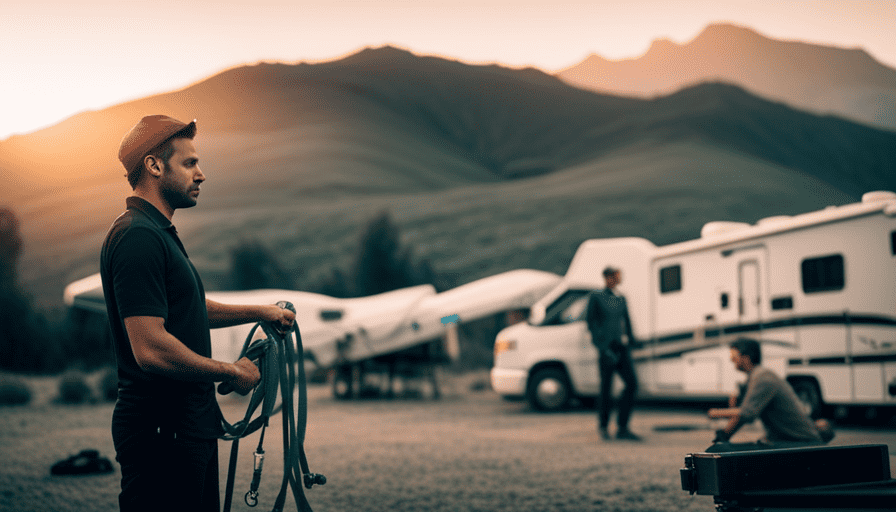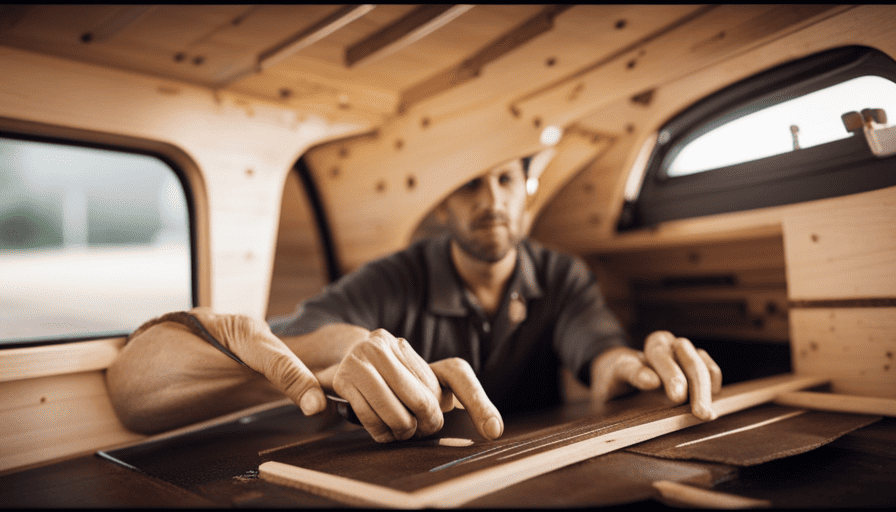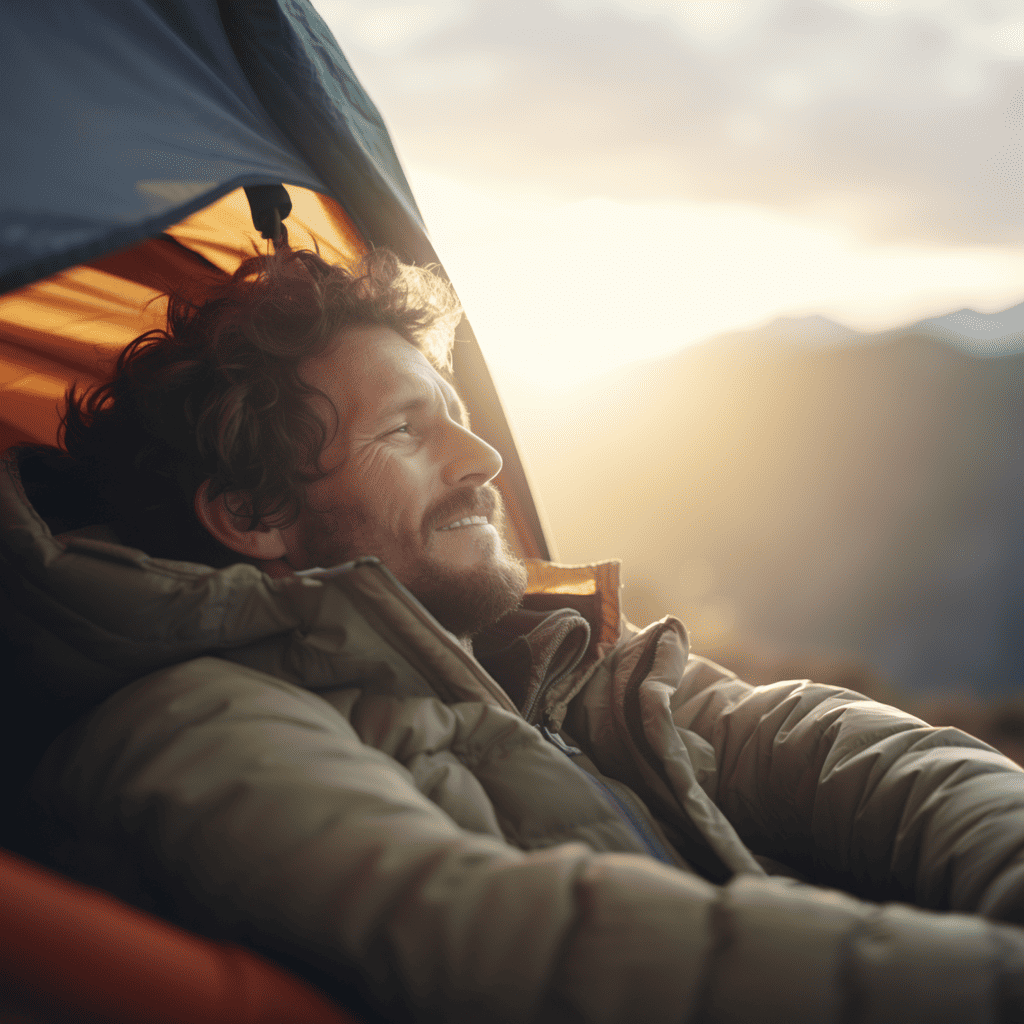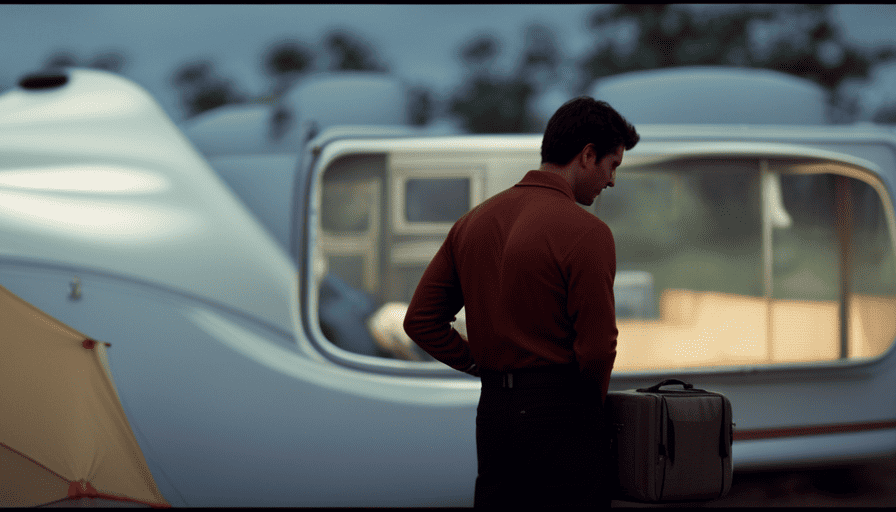Reversing a camper may initially seem daunting, but with practice and knowledge, it can become a skill you execute effortlessly. In this article, I will guide you through the steps to smoothly and confidently reverse your camper.
We’ll explore essential techniques, such as understanding your camper’s dimensions, using mirrors and rearview cameras effectively, and communicating with a spotter. I’ll also share tips on taking it slow and steady, using a brake controller, being mindful of overhangs and obstacles, and learning to interpret a spotter’s hand signals.
With these skills in your arsenal, you’ll be able to navigate tight spaces, tricky turns, and crowded campgrounds like a pro. So, buckle up and get ready to master the art of backing up a camper. Let’s hit the road together!
Key Takeaways
- Understanding dimensions and weight distribution of the camper is crucial for safe maneuvering.
- Effective use of mirrors and rearview cameras adds confidence and control while backing up.
- Clear communication with a spotter through hand gestures and eye contact is essential for safe parking.
- Utilizing small steering movements and going slow and steady reduces the risk of accidents and damage.
Understand Your Camper’s Dimensions
Do you ever find yourself wondering just how big your camper really is? Understanding your camper’s dimensions is crucial when it comes to safely backing it up. Two important factors to consider are weight distribution and preparing for different weather conditions.
Firstly, understanding camper weight distribution is key. You need to know how much weight is on each axle and how it affects your camper’s maneuverability. Ensure that your camper is loaded evenly, with heavier items positioned closer to the axles. This will help maintain stability and prevent swaying while backing up. Additionally, knowing the height and width of your camper is essential to avoid any obstacles or low-hanging branches that could cause damage.
Secondly, preparing for different weather conditions is vital. Windy conditions can significantly impact your ability to back up your camper. Be aware of how wind affects your camper’s stability and adjust your driving accordingly. Rain and snow can also affect traction, so make sure your tires are in good condition and have proper tread to prevent slipping.
Practice in an open space to get comfortable with your camper’s dimensions and handling. This will give you the confidence and skills needed to safely back up your camper in various scenarios.
Practice in an Open Space
Practicing in an open space allows for a sense of freedom and flexibility while ensuring a safe and secure environment. When it comes to backing up a camper, it’s important to have a good understanding of the practice techniques and the benefits of using an open space. Here are three reasons why practicing in an open space is crucial:
-
Ample Room: Having plenty of space around you gives you the freedom to maneuver the camper without worrying about obstacles or tight spaces. It allows you to practice different maneuvers, such as turning, reversing, and parking, without the fear of damaging your camper or any surrounding objects.
-
Reduced Stress: Being in an open space reduces the stress and pressure that comes with backing up a camper. You can take your time, experiment with different techniques, and build confidence in your abilities. It also provides a more relaxed environment where you can focus solely on improving your skills without distractions.
-
Safety First: An open space ensures that you can practice safely, away from traffic or pedestrians. It minimizes the risk of accidents and allows you to concentrate on honing your skills without any external disturbances.
Practicing in an open space is crucial for mastering the art of backing up a camper. Once you feel comfortable and confident in an open space, you can then move on to the next step, which is utilizing your mirrors and rearview camera.
Use Your Mirrors and Rearview Camera
Utilizing your mirrors and rearview camera adds an extra layer of confidence and control to your journey, allowing you to navigate with ease and peace of mind. When it comes to backing up your camper, technology can be your best friend. By using proper techniques and taking advantage of the features available, you can ensure a smooth and safe experience.
One of the most useful tools at your disposal is your rearview camera. This camera provides a clear view of what’s behind you, eliminating blind spots and giving you a better understanding of your surroundings. It’s important to adjust the camera angle properly so you can see the entire area behind your camper.
In addition to the rearview camera, your mirrors are essential for backing up. Make sure they are properly adjusted to give you a wide field of vision. Use them in conjunction with your rearview camera to get a complete picture of what’s happening around your camper.
To help you visualize the importance of utilizing these tools, take a look at the table below:
| Technology | Benefits |
|---|---|
| Rearview Camera | Eliminates blind spots |
| Mirrors | Provides a wide field of vision |
By utilizing technology and using proper techniques, you can confidently back up your camper. Next, we’ll discuss how to communicate with a spotter to further enhance your backing up skills.
Communicate with a Spotter
To enhance your backing up skills, it’s important to communicate effectively with a spotter. Studies have shown that having a spotter can reduce the risk of accidents by 90%. When backing up a camper, clear communication is key to ensuring a safe and successful maneuver. Here are some tips for communicating with a spotter:
-
Use hand gestures: Establish a set of hand signals with your spotter before you begin. These gestures can include pointing in the direction you want to go, signaling to stop or back up, or indicating when it’s safe to continue.
-
Maintain eye contact: Keep your eyes on the spotter at all times while backing up. This will help you stay focused and ensure that you can quickly understand their signals.
-
Give and receive feedback: Regularly check in with your spotter to ensure that you are both on the same page. If you don’t understand a signal or need clarification, don’t hesitate to ask for it.
Remember, clear communication is crucial when backing up a camper. By effectively communicating with your spotter using hand gestures and maintaining eye contact, you can greatly reduce the risk of accidents.
Now, let’s move on to the next section about taking it slow and steady.
Take It Slow and Steady
Ease into the process, allowing yourself to savor each moment as you navigate your vehicle in reverse. Building confidence and developing patience are key when it comes to backing up a camper. Taking it slow and steady is crucial to ensure a safe and successful backup.
To begin, it’s important to communicate with a spotter who can guide you and provide necessary instructions. This helps to eliminate blind spots and reduces the risk of accidents. Once you have a spotter in place, it’s time to start the backup process.
As you begin to move in reverse, remember to use small steering movements. This allows for better control and precision while maneuvering your camper. Keeping your movements gradual and gentle will prevent sudden jerks or sways, which can lead to accidents or damage to your camper.
To further assist you in your backup, refer to the table below for a visual representation of the steps involved:
| Step | Action |
|---|---|
| 1 | Engage reverse gear |
| 2 | Check mirrors and blind spots |
| 3 | Begin moving slowly |
| 4 | Use small steering movements |
| 5 | Continuously communicate with spotter |
| 6 | Adjust as necessary |
By following these steps and incorporating small steering movements, you will gradually build confidence and develop the patience needed to successfully backup a camper. Transitioning into the next section, we will explore the importance of using small steering movements to further enhance your backup skills.
Use Small Steering Movements
When you’re navigating in reverse, remember to make small, gentle steering movements to maintain control and precision, reducing the risk of accidents and damage to your vehicle.
Did you know that over 80% of accidents while backing up are caused by driver error? Using small steering techniques is crucial to ensure a smooth and safe maneuver with your camper.
One of the most common mistakes people make when backing up a camper is using large, abrupt steering movements. This can lead to overcorrection and loss of control, increasing the chances of hitting obstacles or damaging your camper. By making small steering movements, you have better control over the direction and angle of your camper, allowing for more precise maneuvers.
To use this technique effectively, start by turning the steering wheel just a little bit in the direction you want the rear of the camper to go. As you make progress, continue making small adjustments to keep the camper on the desired path. It may take some practice to get the hang of it, but with time, you’ll be able to navigate tight spaces with ease.
Now that you understand the importance of small steering movements, let’s move on to the next section about using your brake controller.
Use Your Brake Controller
Using your brake controller is vital for maintaining control and ensuring a smooth and safe experience while maneuvering in reverse with your RV. The brake controller is an essential component of your camper’s braking system, allowing you to control the amount of braking force applied to your trailer.
When using your brake controller, it’s important to familiarize yourself with its functions and features. Many brake controllers allow you to adjust the brake sensitivity, which determines how quickly the trailer’s brakes engage when you apply the brakes in your vehicle. This adjustment is crucial for finding the right balance between effective braking and avoiding sudden jerks or stops.
Additionally, regularly checking and maintaining your brake controller and emergency brake system is essential for optimal performance and safety.
To use your brake controller effectively, follow these steps:
- Ensure that your brake controller is properly installed and connected to your RV’s electrical system.
- Adjust the brake sensitivity according to your preference and the load you’re towing.
- Test the brake controller by applying the brakes in your vehicle and observing how the trailer responds.
- Regularly inspect and maintain your brake controller and emergency brake system to ensure they’re functioning correctly.
Using your brake controller correctly can make a significant difference in your ability to maneuver your RV safely. However, it’s also crucial to be mindful of overhangs and obstacles, as they can pose a challenge when backing up.
Be Mindful of Overhangs and Obstacles
Now that you know how to use your brake controller effectively, let’s move on to another important aspect of backing up a camper: being mindful of overhangs and obstacles. This is crucial to ensure the safety of both your camper and the surrounding environment.
When backing up a camper, it’s essential to have a clear understanding of the overhang clearance. Overhangs such as tree branches, power lines, or building eaves can pose a significant risk if not taken into account. These obstacles can easily damage your camper or cause accidents if they’re not avoided. Therefore, it’s important to carefully assess the height and width of the overhangs before attempting to back up.
Additionally, you should always be aware of any obstacles in your vicinity. This includes objects like rocks, curbs, or other vehicles that may obstruct your path. By staying vigilant and keeping an eye out for potential obstacles, you can prevent any unnecessary damage to your camper or property.
With a clear understanding of overhang clearance and a keen eye for obstacles, you’ll be better equipped to navigate your camper safely. But before we move on, let’s explore another crucial aspect of backing up a camper: learning to use a spotter’s hand signals.
Learn to Use a Spotter’s Hand Signals
To enhance your backing up skills, familiarize yourself with the hand signals of a spotter. A spotter plays a crucial role in helping you park your camper safely and efficiently. Clear communication between the driver and the spotter is of utmost importance to ensure a smooth and accident-free maneuver.
When backing up a camper, the spotter stands in a position where they have a clear view of both the driver and the surroundings. They use hand signals to guide the driver and provide instructions on how to position the camper accurately. The spotter’s role is to direct the driver by using signals such as pointing in the direction the camper should go, indicating when to stop, and even signaling for the driver to turn the wheels.
Clear communication is key to avoiding any misunderstandings or accidents. The spotter and the driver must establish a system of hand signals before starting the backing up process. This ensures that both parties are on the same page and can effectively communicate without confusion or delay.
By learning and understanding the spotter’s hand signals, you can greatly improve your ability to back up a camper successfully. Stay calm and confident as we move on to the next step of the process, which involves staying aware of your surroundings and maintaining control of the situation.
Stay Calm and Confident
Remaining calm and confident throughout the backing up process is crucial for successfully maneuvering your vehicle and ensuring a safe parking experience. Building confidence is key when it comes to backing up a camper. It can be intimidating at first, especially if you’re new to driving a larger vehicle or have limited experience with towing. However, with practice and a positive mindset, you can master this skill.
One way to build confidence is by familiarizing yourself with your camper and its dimensions. Take the time to measure its length, width, and height, and then practice maneuvering it in an open space. This will help you become more comfortable with its size and handling.
Managing stress is another important factor in staying calm and confident while backing up. It’s natural to feel a bit anxious or stressed when attempting a challenging maneuver, but it’s crucial to keep those emotions in check. Take deep breaths, remind yourself of your capabilities, and stay focused on the task at hand.
Remember, practice makes perfect. The more you practice backing up your camper, the more confident you’ll become. Start with easy maneuvers and gradually work your way up to more challenging ones. With time, patience, and a positive mindset, you’ll be backing up your camper like a pro.
Frequently Asked Questions
What are the recommended hand signals to use when communicating with a spotter while backing up a camper?
Hand signal accuracy and clear communication are essential when backing up a camper. To ensure a smooth and safe maneuver, it’s crucial to establish a reliable system of hand signals with your spotter.
Some recommended hand signals include:
- Thumbs up for ‘straight back’
- Pointing left or right for direction changes
- Waving both hands for ‘stop’
By using these signals effectively, you can enhance the accuracy of your maneuvers and avoid any potential mishaps.
How can I determine if my camper’s dimensions will fit in a specific campsite or parking spot?
Determining if your camper’s dimensions will fit in a specific campsite or parking spot requires careful consideration. Just like fitting a puzzle piece into a designated space, you need to measure the campsite dimensions and compare them to your camper’s size.
Take note of any potential obstacles, such as trees or rocks, that may affect the fit. Additionally, check the parking spot dimensions to ensure a proper fit without obstructing surrounding vehicles.
Are there any specific guidelines for using a brake controller while backing up a camper?
When it comes to brake controller compatibility, it’s important to ensure that your camper’s brake system is compatible with your vehicle’s brake controller. This ensures proper communication between the two systems, allowing for effective braking while towing.
Once you’ve confirmed compatibility, adjusting the brake controller sensitivity is crucial. This allows you to fine-tune the braking force applied to the camper, making it easier to control and maneuver while backing up.
What should I do if I encounter an overhang or obstacle while backing up my camper?
If I come across an overhang or obstacle while backing up my camper, I need to be cautious to avoid any damage. One effective tip is to use a spotter to guide me and provide necessary instructions.
Additionally, I should always be aware of the height and width of my camper, ensuring that I have enough clearance. Parking in tight spaces can be tricky, so it’s crucial to take it slow, use my mirrors, and consider alternative parking options if necessary.
How can I ensure that I am using small steering movements while backing up a camper?
To ensure that I’m using small steering movements while backing up a camper, there are a few ways I can practice.
First, I can start by practicing in an open and empty space to get a feel for the steering sensitivity.
Second, I can use visual aids, such as cones or markers, to help me gauge the distance and make precise adjustments.
Lastly, I should avoid common mistakes like jerking the wheel or turning it too quickly, as this can cause the camper to swing or jackknife.
Are There Different Techniques for Backing Up a Camper?
When it comes to backing a camper, there are various techniques to ensure a smooth experience. One method is using a spotter who can guide you as you reverse, helping avoid obstacles. Learning to use your side mirrors effectively and taking it slow can also enhance your ability to back up a camper without any mishaps. Practice makes perfect in mastering this essential skill.
Conclusion
Backing up a camper can be a daunting task, but with practice and the right techniques, it becomes second nature. Remembering to stay calm and confident is key, as it allows you to think clearly and make precise movements.
Think of yourself as the captain of a ship, maneuvering through tight spaces with grace and precision. Use your mirrors and rearview camera as your navigational tools, and communicate with your spotter using hand signals like a well-choreographed dance.
Take it slow and steady, and soon you’ll be backing up your camper like a pro. Happy travels!











